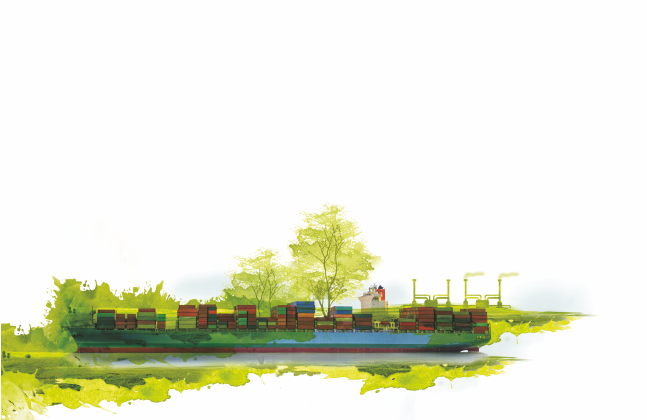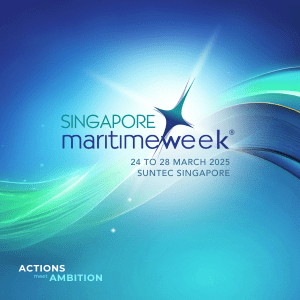Indian Ports Association (IPA), acts as a Think Tank to the Ministry of Shipping, and also rightly hailed as the Centre of Excellence (CoE) helping major ports achieve eminence in their operations and management, thus contributing to the growth of the economy and the country at large. Dr Abhijit Singh, Executive Director, IPA explains how green sustainability and economic growth can coexist.

He emphasizes that it’s high time for maritime transport agencies, both government and private, to be responsive to resolve climate change issues, design and implement measures to lessen repercussions. The shipping industry handles 70 per cent of all world trade’s value, so economic threats to this sector can cause a domino effect on other industries that rely on its services.
The economic growth has come to be seen as a solution for all social and political problems, including poverty, social exclusion and environmental degradation. If India is asked to consider the cost of growth in environmental degradation and social exclusion, it is likely to respond that more growth and more technology are the solution. Thus, sustainable growth taking full advantage of technology and innovation is a way forward. Sustainable growth, for its part, requires the creation of productive assets that conserve nonrenewable resources such as land, water and atmosphere and minimize environmental damage. The response to climate change has to be through both adaptation and mitigation. We must adapt our societies to prepare for some climate change risks. Mitigation efforts must be intensified given the early benefits they can deliver.
India has one of the lowest rates of energy intensity of GDP growth. India’s historic and current levels of per capita GHG emissions remain the lowest amongst the G20 even though in volume terms it is now the third-largest GHG emitter in the world, after China and USA. India continues to face massive development challenges, to tackle this it requires a high level of sustained economic growth. India’s per capita GHG emissions remain a fraction of that of all major emitters and it does not want to pursue the environmentally harmful development as followed by developed countries in their process of industrialization. With Government’s focus on renewables and e-mobility, it is evident that our path to progress is more empathetic to climate vulnerability.
India seeks to meet the climate change challenge by expanding the use of low carbon and renewable technologies and improving energy efficiency of buildings, factories, ports, appliances etc. It is India’s inclusive growth path which is integral to an effective climate change policy for India and studies in India show that low carbon growth pathways are consistent with inclusive growth. India’s Nationally Determined Contributions (NDC) has three numeric targets for 2030: reduce emissions intensity by 33 per cent to 35 per cent from 2005 levels, achieve an installed power capacity of 40 per cent from non-fossil fuel sources and create an additional carbon sink of 2.5–3.0 GtCO2e from forest and tree cover.
How Major Ports can contribute to green sustainability without compromising on efficiency?
Port being an interface between sea and hinterland, marine pollution by the shipping activities gets extended at the ports too. About 30,000 plus vessels of various sizes and types call Indian Ports annually and over 300,000 fishing vessels of various sizes and types are engaged in fishing operations in coastal waters of India that are highly congested and dangerous to safe navigation and a cause for the pollution. Safe and green governance over the maritime domain which accommodate plethora of maritime activities is a challenge. Evaluating pollution impacts on ports, approach channels and in around ports requires consideration of numerous sources of pollution such as
marine vessels, trucks, locomotives, and off-road equipment used for moving cargo, dredging activities, port expansion, handling of hazardous cargo etc. International transport (aviation and shipping) representing around 2.5 per cent of GHG emissions. Shipping contributed with 2.8 per cent of global CO2 emissions and 15 per cent and 13 per cent of global NOx and SOx emissions from anthropogenic sources. The emissions at ports represents 2 per cent of total shipping emission.
Weighing in the environmental perspective for sustained growth, the government has started focusing on making Major Ports across India cleaner and greener through two agenda – one is ‘Green Port Initiatives’ related to port ecosystem environmental issues and second is ‘Swachh Bharat Abhiyaan’ to promote cleanliness at the port premises. Some of these initiatives are:
- Preparation and monitoring plan for green sustainability
- Acquiring equipments required for monitoring and mitigating environmental pollution
- Acquiring dust suppression system, stockpile enclosures, wet fogging, surface wetting etc
- Setting up of sewage/waste water treatment plants/ garbage disposal plant
- Setting up projects for energy generation from renewable energy sources
- Prohibition of disposal of almost all kind of garbage at sea and setting up of shore reception facilities at ports
- Trees plantation in and around port premises, beautification and cleaning of public places
- Cleaning and repairing of all drainages and storm water systems
The Government has also taken many steps for a consistent and smooth implementation towards compliance with the Global Sulphur Cap {0.5% mass/mass max.} IMO regulation effective from 1st January 2020. Indian Oil Corporation Limited (IOCL) has already started supplying Global Sulphur cap compliant fuel oil and is at present available on west coast of India. Complete supply by Hindustan Petroleum Corporation Limited (HPCL) & IOCL is also expected this month.
Concept of smart-green port is being promoted which envisages a zero or negligible port emission with a very high level of efficiency in operations and energy savings. Smart in terms of operations and green in terms of energy usage and waste management would make ports sustainable without any compromise with productivity. In fact this strategy leads to not only reducing the carbon footprint of ports but also increase the efficiency and thus productivity of ports. Adoption of technologies and innovations in areas of digitization and energy systems has ability to transform ports completely.
Combining different digital technologies, such as IoT, AI, Blockchain, Bigdata, Automation etc., offer opportunities to create highly efficient port operations along with improving transparency and removing trust-deficit in information sharing among different stakeholders. Apart from making operations highly efficient though digitization and automation, we must also focus on the kind of energy we use in our operations. Also innovations in to waste management and environment conservation, ports can lead the sustainability endeavors.
- How can women break the invisible barriers and rise up in career to become SheEOs?
There are many ways to reach the top, and some options are more gentlewomanlike than other. You can reach the top by exploiting your colleagues, by grabbing opportunities in front of others, by being strategically egoistic and hard. This is not my way. I would first ask myself the question “Why do I want to lead a company?” What values are important to you, what kind of impact would you like to have, what are the qualities and aspirations you can bring to a company, for its staff, customers, stakeholders and society? Why should it be you? When you have arrived at answers for these questions, then lay a plan, looking 3-5 years ahead. What capabilities and competencies do you need to acquire, in order to get going on that path? How do you need to develop as a leader? Are you intending to rise inside the company you are currently at, or are you a self-starter, would you like to have your own company? Then look for mentors. Look really hard for them, and be very specific with what you want to talk about with such a mentor. Have a strategy with everything you do, value your time. And prioritise time with family and friends, because they are important if you are to become an authentic leader in the future.
- In your opinion what are three typical challenges that women employees in Shipping & Logistics sector face in their career?
Some of us came to this industry by chance, still as a woman, in my experience you always need to have a good answer prepared as to why you are here. Women tend to choose softer subjects than men for their education, this is a scientific fact. I am an engineer myself, and when I was a student, chemical engineering was the only branch which had 50% spread women/men alike, all other branches had far less participation from women. Independent of what education you have however, life is mysterious, and you may well end up in the Shipping & Logistics sector – because your specific knowledge and competences are needed! This is where I currently see a conundrum in this industry; the industry is entering a new decade expected to bring about unprecedented change, with opportunities for new business, great challenges to solve and the threat of disruption from new actors entering the industry from another angle. This will require all hands on deck, and a whole plethora of new competences need to come onboard, and there will be increasing demands for new thinking with regards to leadership. I think many of the change makers for shipping in the future will be young, and they will be women. But we mustn’t allow stubborn company cultures and gender-bias organisational structures take the edge off this talent. Because Shipping can’t afford it. Women in Shipping may not primarily be taking over in the engine rooms, or in the crane cockpits. I think they will enter into roles that Shipping hasn’t had too much of thus far. Fintech, Healthtech, Ecosystem, Renewables, Venture, Collaboration, Sustainability, etc.. This is where you will find your next SheEO.
Sofia Fürstenberg Stott is a popular speaker/moderator and a leading figure in the innovation- and sustainability sphere of the maritime industry. Launching her own advisory at the beginning of 2017, focusing on the transformational journey towards decarbonisation, she has developed Nor-Shipping’s new concept exhibition Blue Economy, and launched the first Opening Oceans Conference, connecting the wider ocean industries for the first time. She has been a visible figure in the Nordics for over a decade, through her tenure as Innovation Portfolio Manager with Maersk, and as a green shipping spearhead with DNVGL. She holds an MBA in Shipping & Logistics from Copenhagen Business School, an MSc in Chemical Engineering from Lund University, and was part of the first cohort to finish the Top Tech Executive Innovation Program at Haas Business School back in 2009.
IMAGE
“The lack of women in maritime leadership roles holds back not only women, but all people, and the sooner this is addressed the sooner we will be able to advance,” avers, Bridget Hogan, Director of Publishing and Membership, The Nautical Institute
Issues in breaking that metaphorical glass ceiling
Obviously there are many reasons – some to do with the qualifications or experience companies demand, some to do with attitudes of potential employers and some to do with acceptance of the particular circumstances women face – such career breaks. In addition there are the hundreds, if not thousands, of little slights and remarks that women have to contend with every day which eat away at their confidence. Lack of confidence is an invisible enemy which is why I will be addressing mentoring at the Maritime SheEO conference. Sometimes it is easier to face the big issue – even if the problem cannot be solved – as it is much easier to articulate that. But the countless attacks and bullying that many women have to contend with constantly eat away at people.
Improving the work environment for women
There are many simple ways and the good news is that if employers do improve the work environment all benefit. Increasingly men are seeking flexible working and career breaks as they do not wish to miss out on their families either. One simple fix is to examine the language of advertisements. It has been shown that it is not only females who can be discouraged from applying for posts if the language used to describe the post is macho. Young men can be too. And if there’s another problem that the maritime industry has to address that is the age discrepancy. It is an aging industry. A survey of Fortune 500 companies shows that companies with diverse leadership innovate more, review information more carefully, and make fewer mistakes.
This was illustrated by Twitter’s cofounder Ev Williams he said a more diverse leadership team would have spotted the platform’s evasive harassment from the beginning. “Had I been more aware of how people not like me were being treated and/ or had I had a more diverse leadership team or board, we may have made it a priority sooner,” he wrote on Twitter.
How can women break the invisible barriers and rise up in career to become SheEOs?
It is complex and there is nothing to beat determination and a thick skin! Having a mentor who can help to turn things positive during bad times can definitely help. Women must be assertive and not be typecast to handling only ‘women’s work’ – whatever that might be. Choose your employer. Sexual harassment is very real and it may force women to turn down a high paying position on a career path to a lowlier post. Speak up and talk out. Let people know what you’re paid and find out what they are paid. Women must understand that the glass ceiling is no reflection of their value as a person or as an employee. Glass ceilings ensure that even if a person has positioned themselves to meet every demand of a role, they will still be denied the opportunity. Even those with key competencies and self-confidence required for the upper levels are still denied advancement. It’s not easy but here’s how things can start to change. Bring the issue out into the open which may mean having some difficult conversations. Do senior managers fear losing out themselves if the organisation becomes more inclusive? Do they worry that it will affect performance?
See where open conversations about these issues lead. There may be a backlash, but this could be countered by emphasising that change needn’t be threatening. It should simply allow those who deserve opportunities to access them, regardless of gender, race, or any other factor. Ask team members for their views. Others may have good suggestions for improvement. Try to encourage organisations to recognise and challenge bias. And did I mention? Get help from a mentor – who may or may not be part of our organisation.
Three typical challenges that women face There is a lot of unconscious bias and even conscious bias in the industry. This is best illustrated by the instance for a lot of posts that candidates have seafaring experience – even if it isn’t central to the job. Fewer than 2% of seafarers are thought to be female so it narrows the potential for those applying for the job from the start. I have heard of board room decision where female candidates have been considered the best but passed over for males because it is considered the organisation has ‘enough’ senior females – probably a token one.








